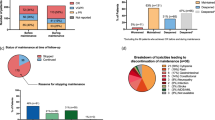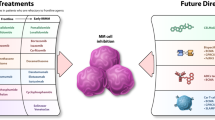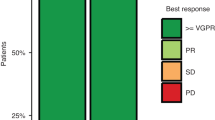Abstract
Comparable clinical efficacy and safety of the reference rituximab (MABTHERA) and its biosimilars has been established in randomized trials. However, safety concerns are often raised when switching from reference to biosimilar products and between different biosimilars. In this prospective observational study we aimed at evaluating the safety of switching between reference and biosimilar rituximab (TRUXIMA and RIXATHON) at Trento General Hospital (Italy). All patients (n = 83) with Non Hodgkin’s Lymphoma (NHL, n = 72) and Chronic Lymphocytic Leukemia (CLL, n = 11) who received rituximab between March 2018 and March 2019 were asked to take part in the study. In 2017 and 2018 two tenders were carried out and two different biosimilars became available in the hospital, these were used sequentially. Thus, patients with or without previous treatments with the originator rituximab either received a biosimilar or were switched between different biosimilars. The incidence of adverse events in these groups of patients is described. The study population received 465 rituximab infusions and all received biosimilars. Fifty patients (60%) experienced at least one switch between different biosimilars or between rituximab originator and biosimilar, whereas 33 (40%) received one of the two biosimilars and one patient received reference rituximab. Adverse events (n = 146) were reported in 71 patients (84.5%). Treatment-related grade 3–4 events were reported in 5 patients (5.9%), whereas grade 1 rituximab related infusion events were observed in 6 patients (7.1%). No safety signal emerged in association with the use of a specific biosimilar nor with the practice of switching. Adverse events were similar, in terms of seriousness and frequency, to those described in the literature, providing further support to the clinical safety of rituximab biosimilars.
Similar content being viewed by others
Introduction
Biosimilars are approved on the basis of a comprehensive comparability exercise aimed at establishing the similarity to the reference medicinal products in terms of quality, biological activity, safety and efficacy1.
The first biosimilars introduced in Europe in 2006, were biosimilar somatropins2. Until recently, only biosimilars of these lower molecular-weight biologics were available. This changed in September 2013 when the European Medicines Agency (EMA) recommended the granting of marketing authorization for the first time for two biosimilar versions of the monoclonal antibody (mAb) infliximab3.
As of 1st January 2021, there are 58 authorized products in the EU and 29 in the USA4. Existing data on switching for selected biosimilars have been generated from several studies5,6,7. In more than 10 years of clinical experience, no substantial clinical and safety differences have been detected8. However, especially for newly marketed biosimilars, concerns are raised with respect to the practice of switching in patients already treated with a specific biologic product (either reference or biosimilar)9.
Differently for the FDA, the EMA does not make a distinction between biosimilars and interchangeable products and advice to prescribers fall under the responsibility of member states10.
In Europe, biosimilars have become a reality, with some biosimilars achieving market share of > 90%, while in the USA, the uptake of biosimilars has been modest thus far11.
The first biosimilar rituximab was approved in 20179. The equivalence between reference rituximab (MABTHERA) and its biosimilars—in terms of pharmacokinetics, pharmacodynamics, efficacy, safety and immunogenicity—has been demonstrated in randomized, double-blind, controlled trials12,13,14,15.
After a careful review of the scientific evidence on rituximab, hematologists and pharmacists working at Trento General Hospital agreed that reference and biosimilar products could be used interchangeably in all patients, both naïve and experienced ones. Consequently, in 2017 and 2018 two tenders were carried out and two different biosimilars became available in the hospital: TRUXIMA (Mundipharma) in the first year and RIXATHON (Sandoz) in the second one. It was also agreed to conduct a prospective observational study specifically focusing on safety to build patient and physician confidence.
The aim of the study was to document any adverse event (AE) reported in association with the use of biosimilar rituximab and with the practice of switching between different products in patients with Non Hodgkin’s Lymphoma (NHL) and Chronic Lymphocytic Leukemia (CLL).
Methods
The study was conducted in accordance with ethical principles derived from guidelines that included the Declaration of Helsinki16, as well as following all relevant local requirements. The Ethics Committee of the Health Trust of the Autonomous Province of Trento approved the study protocol (2018/n.4586). Informed consent was secured from all subjects in this study. Patients were treated according to the usual practice and no additional procedure was carried out. Each patient was informed about the objectives of the study and provided written informed consent to collect and analyze data for research purposes.
The study population consisted of adult patients with NHL and CLL, consecutively admitted into the Hematology Unit of the Trento General Hospital from March 10th 2018 to March 10th 2019, whose therapy included rituximab administration. Patients were followed up until the first of the following dates: last follow up visit, death, end of study (30 September 2019).
Baseline characteristics were ascertained at the time of the first infusion of rituximab (dosed at 375 mg/m2 as part of standard treatment), during the study period. Data were collected on patient characteristics (i.e., diagnosis, age, body surface area, performance status), previous treatment and concomitant medications, premedications, rituximab indications, dosage and administration.
During the study period, patients may have received: (a) either a biosimilar or the reference product (no-switch group); (b) two biosimilar products (switch during the study period); (c) a rituximab formulation (reference or biosimilar) that was different from the one received before the study period (anamnestic switch).
Adverse events (AEs) of interest consisted of Infusion Related Reactions (IRR) (i.e., type of reaction, treatment of reaction, duration of interruption of infusion) and other adverse events occurring between different infusions, regardless of their severity (grade 1–4). Safety follow-up took place at every administration of rituximab; information on adverse events occurring at home was obtained at every clinical access (at least once per month). The causality assessment for all drug–event couples was made by the attending physicians using the Naranjo algorithm17.
NHL and CLL disease activity was assessed according to the local clinical practice routine, after the third cycle (week 9) and at the end-of-treatment visit, and was grouped as overall response rate, complete response, partial response, stable disease, progressive disease18,19.
Performance status was assessed by clinicians using the Eastern Cooperative Oncologic Group Scale (ECOG) scale20.
We described the characteristics of patients included in the study using counts with percentages and median with interquartile range (IQR) for categorical and continuous variables, respectively. The incidence of AEs among patients with “no-switch”, “switch during the study period” and “anamnestic switch” was analysed through a Chi-square test for categorical variables. Both the number of patients and the number of infusions were used as denominator of the events of interest. The study population represented the experience of a single hospital and no formal sample size calculation was carried out.
Results and discussion
Eighty-three patients (37 women and 46 men) affected by NHL (n = 72) and CLL (n = 11) were included in the study (Table 1). Patients had a median age of 71 years (interquartile range-IQR 63–79 years) and more than 20% had a performance status ≥ 3. The median follow-up of the patients was 10.5 months (IQR 7–14 months).
During the study period the patient population received 465 infusions of intravenous rituximab (163 TRUXIMA, and 302 RIXATHON). The median dosage received was 652 mg (range 500–900 mg). The median number of infusions per patient was 5.6 (range 1–8 infusions). All patients (n = 83) received biosimilars. Among non-switchers, 33 patients (40%) received a biosimilar formulation. At least one switch was experienced by the remaining 50 patients (60%): 26 (31%) during the study period and 24 (29%) before the study period (anamnestic switch).
Adverse events (n = 146) were reported in 71 patients (85.5%). Fifty-five (66.3%) and 10 (12.0%) patients had respectively neutropenia or anemia of grade 1–2. Treatment-related grade 3–4 AEs were reported in five patients (6.0%): neutropenia in two patients, and febrile neutropenia, thrombocytopenia, liver toxicity, in one patient each. Six patients experienced rituximab related adverse events of grade 1, which is consistent with the scientific literature (Table 2)21.
The incidence of AEs was similar in patients who received one or two biosimilar formulations, both for any events (32/33 patients in the no switch group vs 25/26 patients with a switch during the study period, p = 0.86) and for events of grade 3–4 (2/33 vs 1/26; p = 0.70).
The proportion of AEs was lower in patients who were receiving a rituximab formulation (one biosimilar or the other) that was different from the one before the study period (14 out of 24 patients, 58%; 2 events of grade 3–4) (data not shown).
After a median follow-up of 10 months, adverse events reported were similar in terms of seriousness and frequency, regardless of rituximab formulation and switching. The incidence of events was lower only in the group of prevalent patients who had been already treated in the past with a different rituximab formulation (anamnestic switching).
To our knowledge, this is the first real‐life cohort study assessing the safety of switching between different rituximab formulations (biosimilars and originator) in NHL and CLL patients.
Although some open-label studies have shown an increased number of withdrawals or AEs following a switch, these outcomes were less frequently observed in randomized studies9,21 suggesting the potential occurrence of a “nocebo” effect resulting from negative expectations toward the biosimilar22.
The results of this study support the position that switching between biosimilars, or from reference rituximab to its biosimilars, as part of routine clinical practice in NHL and CLL patients, has the same safety profile expected in patients continuously treated with reference rituximab. Data from post-marketing studies and real-world experience are needed to provide additional information to supplement the strong evidence already obtained on biosimilars from RCTs.
The increasing availability of biosimilars has led to significant healthcare savings and provided greater patient access to high cost therapeutics23. However, the cost-saving potential depends on various factors, such as the price of the reference product and the competition market24.
A cost-analysis study conducted in Europe, predicted that switching to a rituximab biosimilar would save €56.82 million over a year25.
In the setting of our hematology unit of a general hospital, this shared approach has increased clinicians and patients confidence in biosimilars with respect to safety, generating at the same time a 45% reduction in the price of rituximab (around 400,000 euros savings in one year).
Data availability
The data that support the findings of this study are available on request from the corresponding author [S.U.]. The data are not publicly available because they contain information that could compromise research participant privacy/consent.
References
Pasina, L., Casadei, G. & Nobili, A. Biological agents and biosimilars: Essential information for the internist. Eur. J. Intern. Med. 33, 28–35 (2016).
Omnitrope, European Public Assessment Report, 12 April 2006. https://www.ema.europa.eu/en/documents/product-information/omnitrope-epar-product-information_en.pdf. Accessed March 1, 2020.
European Medicines Agency (2013) European public assessment reports: Biosimilars. https://www.ema.europa.eu/en/documents/press-release/european-medicines-agency-recommends-approval-first-two-monoclonal-antibody-biosimilars_en.pdf.
Food and Drug Administration. Purple book: Lists of licensed biological products with reference product exclusivity and biosimilarity or interchangeability evaluations. https://purplebooksearch.fda.gov/. Accessed January 28th, 2021.
Strik, A. S. et al. Serum concentrations after switching from originator infliximab to the biosimilar CT-P13 in patients with quiescent inflammatory bowel disease (SECURE): An open-label, multicentre, phase 4 non-inferiority trial. Lancet Gastroenterol. Hepatol. 3(6), 404–412 (2018).
Yoo, D. H. et al. Efficacy and safety of CT-P13 (biosimilar infliximab) in patients with rheumatoid arthritis: Comparison between switching from reference infliximab to CT-P13 and continuing CT-P13 in the PLANETRA extension study. Ann. Rheum. Dis. 76(2), 355–363 (2017).
Goll, G. L. et al. Long-term efficacy and safety of biosimilar infliximab (CT-P13) after switching from originator infliximab: Open-label extension of the NOR-SWITCH trial. J. Intern. Med. 285(6), 653–669 (2019).
Biosimilars Medicines Group, A Medicines for Europe sector group. Docket submission and presentaton to the Oncologic Drugs Advisory Committee meeting of 13 July 2017. [commentary]. https://www.regulations.gov/document?D=FDA-2017-N-2732-0006.
Moots, R. et al. Switching between reference biologics and biosimilars for the treatment of rheumatology, gastroenterology, and dermatology inflammatory conditions: Considerations for the clinician. Curr. Rheumatol. Rep. 19(6), 37 (2017).
Ebbers, H. C. & Schellekens, H. Are we ready to close the discussion on the interchangeability of biosimilars?. Drug Discov. Today 24(10), 1963–1967 (2019).
EO’Callaghan, J., Barry, S. P. & Bermingham, M. Regulation of biosimilar medicines and current perspectives on interchangeability and policy. Eur. J. Clin. Pharmacol. 75, 1–11 (2019).
Smolen, J. S. et al. A randomised, double-blind trial to demonstrate bioequivalence of GP2013 and reference rituximab combined with methotrexate in patients with active rheumatoid arthritis. Ann. Rheum. Dis. 76(9), 1598–1602 (2017).
Park, W. et al. Comparison of biosimilar CT-P10 and innovator rituximab in patients with rheumatoid arthritis: A randomized controlled Phase 3 trial. MAbs 10(6), 934–943 (2018).
Jurczak, W. et al. Rituximab biosimilar and reference rituximab in patients with previously untreated advanced follicular lymphoma (ASSIST-FL): Primary results from a confirmatory phase 3, double-blind, randomised, controlled study. Lancet Haematol. 4(8), e350–e361 (2017).
Ogura, M. et al. Efficacy, pharmacokinetics, and safety of the biosimilar CT-P10 in comparison with rituximab in patients with previously untreated low-tumour-burden follicular lymphoma: A randomised, double-blind, parallel-group, phase 3 trial. Lancet Haematol. 5(11), e543–e553 (2018).
World Medical Association. World Medical Association Declaration of Helsinki: Ethical principles for medical research involving human subjects. JAMA 310, 2191–2194 (2013).
Naranjo, C. A. et al. A method for estimating the probability of adverse drug reactions. Clin. Pharmacol. Ther. 30, 239–245 (1981).
Cheson, B. D. et al. Revised response criteria for malignant lymphoma. J. Clin. Oncol. 25(5), 579–586 (2007).
Hallek, M. et al. Guidelines for the diagnosis and treatment of chronic lymphocytic leukemia: A report from the International Workshop on Chronic Lymphocytic Leukemia updating the National Cancer Institute-Working Group 1996 guidelines. Blood 111(12), 5446–5456 (2008).
Oken, M. M. et al. Toxicity and response criteria of the Eastern Cooperative Oncology Group. Am. J. Clin. Oncol. 5(6), 649–655 (1982).
Jørgensen, K. K. et al. Switching from originator infliximab to biosimilar CT-P13 compared with maintained treatment with originator infliximab (NOR-SWITCH): A 52-week, randomised, double-blind, non-inferiority trial. Lancet 389(10086), 2304–2316 (2017).
Glintborg, B. et al. A nationwide non-medical switch from originator infliximab to biosimilar CT-P13 in 802 patients with inflammatory arthritis: 1-year clinical outcomes from the DANBIO registry. Ann. Rheum. Dis. 76(8), 1426–1431 (2017).
IMS Health. The impact of biosimilar competition in Europe. (2019). https://ec.europa.eu/docsroom/documents/38043.
Chopra, R. & Lopes, G. Improving access to cancer treatments: The role of biosimilars. J. Glob. Oncol. 3, 596–610 (2017).
Janjigian, Y. Y., Bissig, M., Curigliano, G., Coppola, J. & Latymer, M. Talking to patients about biosimilars. Future Oncol. 14, 2403–2414 (2018).
Acknowledgements
The authors would like to thank the patients participating in this study.
Author information
Authors and Affiliations
Contributions
All authors were involved in drafting the article or revising it critically for important intellectual content, and all authors approved the final version to be published. S.S.A., G.T. and S.A.M.U. had full access to all of the data in the study and take responsibility for the integrity of the data and the accuracy of the data analysis.
Corresponding author
Ethics declarations
Competing interests
The authors declare no competing interests.
Additional information
Publisher's note
Springer Nature remains neutral with regard to jurisdictional claims in published maps and institutional affiliations.
Rights and permissions
Open Access This article is licensed under a Creative Commons Attribution 4.0 International License, which permits use, sharing, adaptation, distribution and reproduction in any medium or format, as long as you give appropriate credit to the original author(s) and the source, provide a link to the Creative Commons licence, and indicate if changes were made. The images or other third party material in this article are included in the article's Creative Commons licence, unless indicated otherwise in a credit line to the material. If material is not included in the article's Creative Commons licence and your intended use is not permitted by statutory regulation or exceeds the permitted use, you will need to obtain permission directly from the copyright holder. To view a copy of this licence, visit http://creativecommons.org/licenses/by/4.0/.
About this article
Cite this article
Urru, S.A.M., Spila Alegiani, S., Guella, A. et al. Safety of switching between rituximab biosimilars in onco-hematology. Sci Rep 11, 5956 (2021). https://doi.org/10.1038/s41598-021-85563-1
Received:
Accepted:
Published:
DOI: https://doi.org/10.1038/s41598-021-85563-1
This article is cited by
-
Additional Data in Expanded Patient Populations and New Indications Support the Practice of Biosimilar-to-Biosimilar Switching
BioDrugs (2024)
-
Severe Hypersensitivity Reactions at Biosimilar versus Originator Rituximab Treatment Initiation, Switch and Over Time: A Cohort Study on the French National Health Data System
BioDrugs (2023)
-
A Developer’s Perspective on Clinical Evidence and Benefits for Rituximab Biosimilar Uptake, with a Focus on CT-P10
Clinical Drug Investigation (2022)
-
Switching from One Biosimilar to Another Biosimilar of the Same Reference Biologic: A Systematic Review of Studies
BioDrugs (2022)
Comments
By submitting a comment you agree to abide by our Terms and Community Guidelines. If you find something abusive or that does not comply with our terms or guidelines please flag it as inappropriate.



